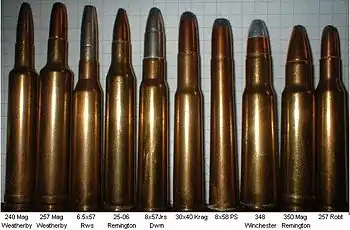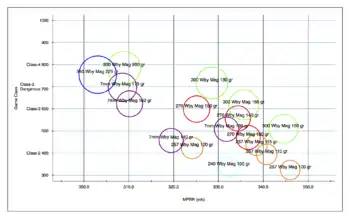Weatherby
Weatherby, Inc. is an American gun manufacturer founded in 1945 by Roy Weatherby. The company is best known for its high-powered magnum cartridges, such as the .257 Weatherby Magnum, .270 Weatherby Magnum, .300 Weatherby Magnum, .340 Weatherby Magnum and the .460 Weatherby Magnum. The company's headquarters is based in Sheridan, Wyoming.
 | |
| Type | Incorporated company |
|---|---|
| Founded | 1945 |
| Founder | Roy Weatherby |
| Headquarters | , |
Key people |
|
| Products |
|
| Website | weatherby.com |
History
The original production rifles by Roy Weatherby were built on commercial Mauser actions manufactured by FN, Brevex (magnum), and Mathieu (left hand). Weatherby would build a custom rifle from a customer's specifications for bespoke rifles, using any action the customer requested - provided the action was strong enough to tolerate the pressures for their desired cartridge. Weatherby manufactured his rifles for many years at his small facility located in South Gate, California, until 1956 when he contracted with Sako to continue building his firearms that were based on the Weatherby-FN Mauser actions. Some custom rifles were still produced in South Gate following this contract.[1]
Weatherby's first break from designs based on Mauser actions came in 1956 when he commissioned the Danish firm of Schultz & Larsen to build the 378 Weatherby Magnums utilizing the Schultz & Larsen Model 54 bolt-action. This action was very stout and had several features that would be integrated into Weatherby's future proprietary rifle designs, including a low bolt-lift and triple gas-escape ports in the bolt.
In 1958, after several years of development, Roy Weatherby introduced the Mark V bolt action, his first proprietary design developed totally in-house by Weatherby himself and with his head engineer, Fred Jennie. The newly designed rifle had to be built to withstand the higher pressures produced by Weatherby's experimental cartridges, which exceeded 100,000 pounds per square inch [psi] (690,000 kPa). The first Weatherby Mark V actions were manufactured in the U.S. by Pacific Founders, Inc. and the rifles were assembled and finished at the Weatherby facility in South Gate. The demand for the new Mark V rifles quickly exceeded Weatherby's manufacturing capacity, so the company contracted with J. P. Sauer in West Germany to produce the rifles. Manufacturing of the Mark V continued in West Germany until the early 1970s when material and labour costs led Weatherby to shift production to Howa in Japan. Some say the machining and finishing of the Howa manufactured Mark Vs was an improvement over that of the quality of the Sauer made guns. Manufacturing of the Mark V was moved back to the United States in 1995, where the Mark V has been built under contract by both Saco Defense (acquired by General Dynamics in 1998) and Acrometal/ATEK ever since.[1]
The Mark V action remained relatively unchanged during the first five years of its production, until manufacturing moved from PFI in the United States to J. P. Sauer in Germany. The Sauer produced version differed from that manufactured in the United States, with the safety moved from the receiver to the bolt and the smooth surface of the safety found on the US made versions was replaced with a fluted surface. The first major change to the Mark V came in 1963 when Weatherby shortened and trimmed the design of the action around their 224 Weatherby Magnum varmint round, which had been designed in 1964. The bolt in the smaller Mark V action had six locking lugs, as opposed to the nine locking lugs found on the parent rifle chambered in the 378 Weatherby Magnum. Rifles chambered for the new 224 Weatherby Magnum cartridge were dubbed the "Varmintmaster." The Varmintmaster was later offered in a version chambered for the 22-250 Remington, making this the first non-Weatherby cartridge offered in the Mark V rifle. A version of the Mark V rifle equipped with a nine lug bolt and chambered in .30-06 was also made available in 1967. These two cartridges, the 30-06 and 22-250, remained the only two non-Weatherby chamberings offered in production Mark V rifles until the mid-1990s, although Weatherby would still build a custom Mark V to a customer's specifications in virtually any caliber. As all Mark V rifles made after 1967 that were chambered for non-Weatherby standard calibers (not magnum cartridges) were equipped with the six-lug version of the bolt, this makes versions with a nine-lug bolt chambered in 30-06 (whether made in Germany or Japan) somewhat rare.[1]
In the late 1960s, Weatherby contracted with Howa of Japan to build a Weatherby rifle that would be more affordable for the average hunter. The result was the Weatherby Vanguard which was introduced in 1970, the same year that production of the Mark V moved to Japan.[2] The Vanguard was based on the Howa 1500 bolt action and was initially only offered in standard calibers, and it provided an attractive alternative for buyers in the market for a sporting bolt-action rifle like the Winchester Model 70 or Remington Model 700. The Vanguard has since also been made available chambered for select Weatherby magnum calibers.[3]
In January, 2018 the company announced it was relocating from Paso Robles, California to Sheridan, Wyoming.[4]
Products
Rifles

Weatherby offers only two lines of centerfire rifles: the Mark V and the Vanguard. The Mark V barreled action is manufactured by ATEK in Brainerd, Minnesota, while the barrel and action for the Vanguard are still manufactured by Howa in Japan. Final assembly of the Mark V and Vanguard is performed at Weatherby's company headquarters in Sheridan, Wyoming, in the United States. The Mark V has two action size variants; a larger nine-lug bolt-action is used for all larger Weatherby magnum calibers, and a smaller six-lug action (in two lengths) is used for the 240 Weatherby and all other non-Weatherby cartridges (as the 224 Weatherby Magnum is no longer a standard option). Both the Mark V and Vanguard are available as sub-MOA rifles which were replaced with "Range Certified" rifles in various models. These variants range from blued to stainless steel metal with kevlar or wooden stocks, and are available in calibers including the .223 Remington (Vanguard only) through to the .300 Weatherby Magnum. Rifles chambered in either the .340 Weatherby Magnum or the .460 Weatherby Magnum are only available on the Mark V as these cartridges require the stronger bolt.[3][5]
The Weatherby rifles come with a three shot sub-MOA guarantee of accuracy from a cold bore on all models using Weatherby or premium ammunition. Generally regarded as of higher quality than Remington or Winchester rifles in the same class, Weatherby Mark V rifles are considerably more expensive in terms of unit cost and ammunition. However, the Vanguard models are competitively priced with other makes and models.[3][6]
Scopes
Weatherby no longer manufactures rifle scopes or other optical products. The company did produce the Mark XXI Scope, which was manufactured in Japan between 1964 and 1989. The company offered the Sightmaster Spotting Scope with magnification ranges of 20x-45x from 1972 to 1982, and 20x-60x from 1983 to 1989. Earlier optics also included the Imperial Scope and were produced for Weatherby by Hertel & Reuss and manufactured in West Germany, between 1964 and 1973. Weatherby manufactured its line of Premier Scopes in Japan from 1973 to 1982, and its Supreme Scopes - also manufactured in Japan - from 1983 to 1994.[7]
Shotguns
Weatherby offers a line of shotguns for bird hunting, and skeet shooting. Weatherby produces four types of shotguns, each type available in two different models: over-under double barrel, side-by-side double barrel, pump-action, and semi-automatic. Weatherby's shotguns (the "D'Italia" line) are made in Italy through a collaborative effort with Italian gunmaker Fausti Stefano.[8]
Calibers
Firearms designer and cartridge pioneer Charles Newton, often colloquially referred to as the "Father of High Velocity", was the first to build a hunting cartridge and rifle capable of firing a bullet at over 3,000 feet per second (910 m/s). Weatherby was able to develop their rifles following this new trend in the design of high-velocity hunting calibers. In the late 1980s, Remington's Ultra Mag series of unbelted magnum cartridges - returning to the Newton-style of cartridge design - provided Weatherby with new competition. However, Weatherby still makes the most powerful commercially available hunting cartridge in the world with its .460 Weatherby.[9][10]
According to Weatherby's website, the company's full line up of calibers consists of the:

- .224 Weatherby Magnum
- .240 Weatherby Magnum
- .257 Weatherby Magnum
- 6.5 RPM (Rebated Precision Magnum)
- 6.5-300 Weatherby Magnum
- .270 Weatherby Magnum
- 7mm Weatherby Magnum
- .300 Weatherby Magnum
- .340 Weatherby Magnum
- .30-378 Weatherby Magnum
- .338-378 Weatherby Magnum
- .375 Weatherby Magnum
- .378 Weatherby Magnum
- .416 Weatherby Magnum
- .460 Weatherby Magnum
- Some Weatherby cartridges (circle size proportional to recoil)
 Game class vs 6-inch maximum point blank range
Game class vs 6-inch maximum point blank range Sectional density vs ballistic coefficient
Sectional density vs ballistic coefficient
Weatherby offers rifles chambered in:
- .17 HMR
- .204 Ruger
- .22 LR
- .223 Remington
- .22-250 Remington
- .243 Winchester
- .25-06 Remington
- .270 Winchester
- .270 WSM
- 7mm-08 Remington
- .280 Remington
- 7mm Rem Mag
- .308 Winchester
- .30-06 Springfield
- .300 WSM
- .300 Winchester Magnum
- .338-06 A-Square
- .338 Winchester Magnum
- .35 Whelen
- .375 H&H Magnum
- .458 Lott
Weatherby also produces the .220 Weatherby Rocket cartridge, designed by Roy Weatherby. It does not have the typical double-radius shoulder like the rest of the Weatherby calibers, and it is not a belted magnum. It is best described as an "improved" version of the .220 Swift.
Weatherby shotguns are available in several common cartridges, from the .410 bore up to the 12 gauge.
References in Popular Culture
"Weatherby" is mentioned in "Yvette" by Jason Isbell on the Southeastern album.
References
- Walter, John (2006). The rifle story: an illustrated history from 1776 to the present day. MBI Publishing Company. pp. 268–274. ISBN 978-1-85367-690-1.
- Wieland, Terry (2006). Dangerous-Game Rifles. Down East Enterprise Inc. p. 106. ISBN 978-0-89272-691-2.
- Petzal, David E. (2008). "Accuracy Guaranteed Weatherby's sub-MOA Vanguard Performs as Promised". Field & Stream. 112 (11): 94.
- "After 30 years in SLO County, rifle manufacturer Weatherby is leaving for Wyoming"
- Lewis, Jack (2007). The Gun Digest Book of Assault Weapons. Gun Digest Books. pp. 22–27. ISBN 978-0-89689-498-3.
- Shideler, Dan (2011). Gun Digest 2012. Gun Digest Books. pp. 208–209. ISBN 978-1-4402-1447-9.
- "Weatherby", "Roy" (25 April 2017). "Weatherby". weatherby.com. weatherby Inc. Retrieved 25 April 2017.
- McNab, Chris (2007). Sporting Guns: A Guide to the World's Rifles and Shotguns. Macmillan. pp. 59–60. ISBN 978-0-312-36823-4.
- Wieland, Terry (2006). Dangerous-Game Rifles. Countrysport Press. p. 185. ISBN 978-0-89272-691-2.
the .460 was to offer the most powerful commercial cartridge, and he succeeded.
- Capstick, Peter Hathaway (1984). Safari: The Last Adventure. St. Martin's Press. p. 94. ISBN 978-0-312-69657-3.
The Weatherby is the most "powerful" shoulder-fired commercially available caliber you can buy.
Further reading
- MacPhee, William (1987). Rare Breed: The Entrepreneur, an American Culture. Probus Pub Co. p. 227. ISBN 978-0-917253-75-1.
- Van Zwoll, Wayne (2000). The Hunter's Guide to Ballistics: Practical Advice on How to Choose Guns and Loads, and Use them Effectively. The Lyons Press. pp. 26–27. ISBN 978-1-58574-375-9.
External links
- Official site
- "The Hunter's Big Wallop." Popular Mechanics, September 1951, pp. 73–77, 1951 article on Weatherby's specialized arms and their new factory in California.
